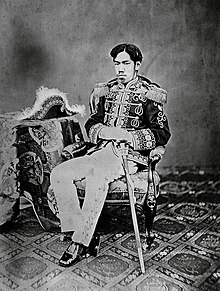 |
| Yoshida Shoin |
Do you know the person who tried to sneak into the Perry’s Black Ship, the first ship which came to open Japan to the world? It is Yoshida Shoin who tried to change Japan in the Edo and Meiji era. He is known as a samurai, thinker, educator and community scholar. Generally he is said to be the spiritual leader of the Meiji Restoration. The information from textbook in school is not at all about him. His essence is far away from people we see in the textbook. If I explain his character in one word, crazy is only word which matches him. He did crazy things which usually people do not. I will describe him how great and crazy he was in the view of his background, personality and what we can learn from him.
He was born in Hagi in the Choshu region of Japan as Sugi Yurinosuke. He studied at Shokasonjuku, which is a cram school that his uncle opened. In 1982, he planned to travel to the north-east (Tohoku region) with his friends and to keep the promise of departure, he left the Choshu clan without getting any permission from them. After arriving at Edo, he was accused of a crime and lost his rank of samurai and relations between him and his family. In 1853, when Perry came to Uraga, his mind was heading to go abroad. After that, Russian warship came and he and his friend tried to sneak into the ship but they could not succeed because the warship left earlier than the schedule because of the war. They did the same thing to Perry’s Black Ship but were told to go back because if Perry brought them to U.S it would have been illegal. Their baggage were on the boat which they used to sneak into the Black Ship and the boat was already floated somewhere so they thought they would be caught easily. Therefore, they surrendered not to humiliate themselves. They were sent to prison but a few years later, Shoin was released from the prison and opened Shoukason-juku, the same name as his old school, and educated many talented people.
As I mentioned in the beginning of essay, he was a crazy person. From his totally unexpected action, we can read some of his character. By the way, he was a believer of Youmeigaku which is consciousness that we should not just obey the power but act with responsibility. I will explain this Youmeigaku more specifically and simply by using their precept. First, even if an action is illegal, it is just if you thought it is just. Second, if you did not act what you studied, it means learning is for nothing. Third, every human has moral fiber inborn so as long as you follow it, your action is just. These are his consciousness and also he left a quote which shows his personality. The best quote showing his character is, “if you set an aim, you have to start from the day you set it” (Yoshida Shoin). From his actions such as sneaking into warship and leaving Choshu clan without permission, he completely put into practice this quote. From these elements, we can say he is direct and active.
What we should learn from him is his ability to take action and accomplish a purpose. However, the teller has often spruced up history. Some people say he is dangerous and I think this is true. In fact, he tried to assassinate some people who he thought were wrong. There is doubt about whether he tried to assassinate Perry. His justice is not justice for all people which means he was just evil for the Bakufu government. Whether he is right or not, his way of living is something we can respect because he did it for the country not for himself.
In conclusion, I wrote some criticism of him but he receives recognition from many people and his way of life is admirable. For instance, his action surprised Perry but he felt admiration for Shoin. There is less necessity now for people like him because of change of age but thanks to people who changed or tried to change Japan, what we have today is result of their effort and great success.
References
Hiruta, R. Yoshida Shoin sonohito wo miru (Look at Yoshida Shoin). Retrieved on 17/07/2013 from http://homepage2.nifty.com/kumando/mj/mj011005.html
Quotes of Yoshida Shoin. (9/10/2011). Retrieved on 17/07/2013 from http://matome.naver.jp/odai/2131813940838887701
Yoshida Shoin (10/7/2013). Retrieved on 15/07/2013 from http://en.wikipedia.org/wiki/Yoshida_Sh%C5%8Din
Yosshi (8/8/2012). Yoshida Shoin ha tadano terorisuto ni suginai (Yoshida Shoin was a just a terrorist). Retrieved on 17/07/2013 from http://blog.nihon-syakai.net/blog/2012/08/002325.html
